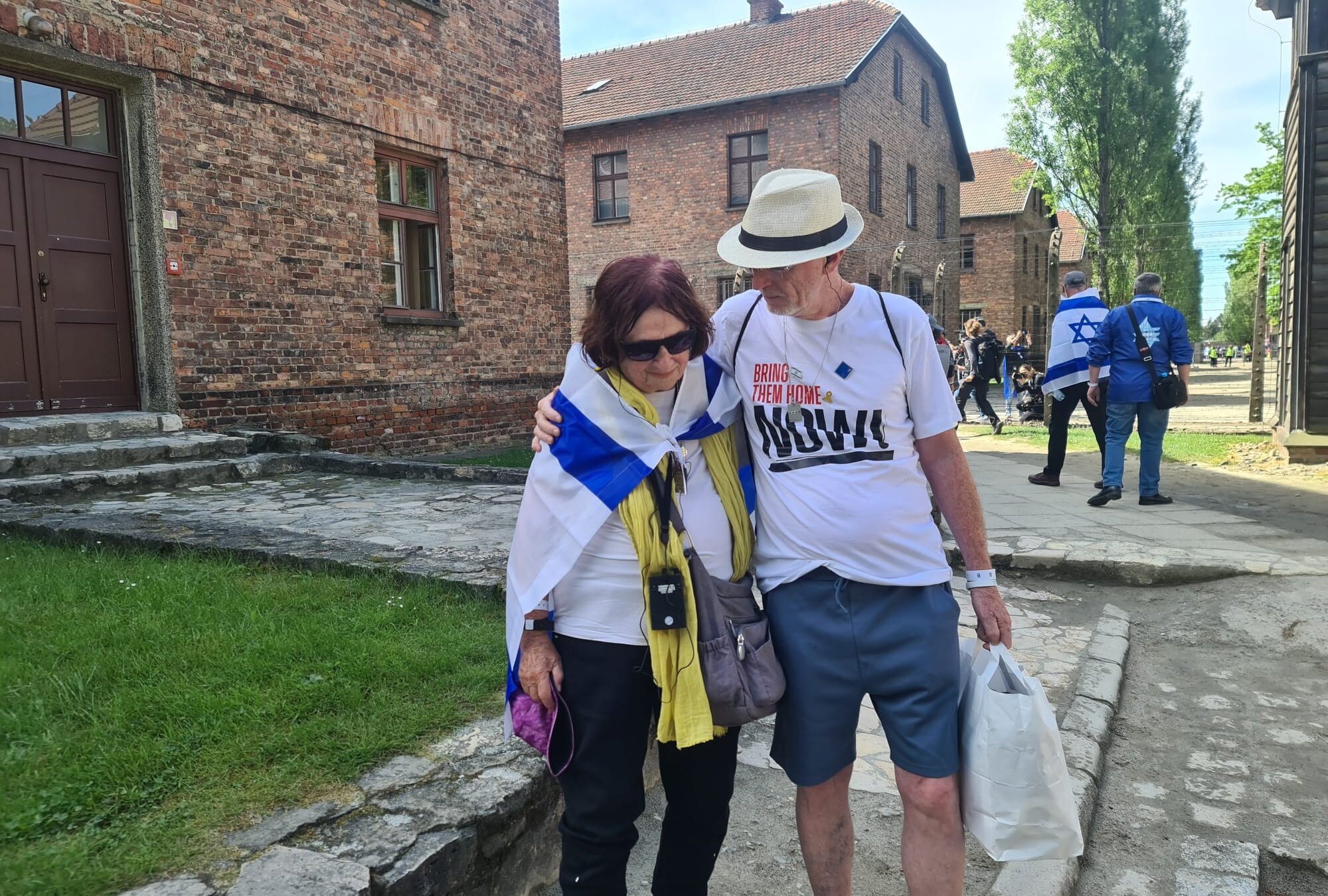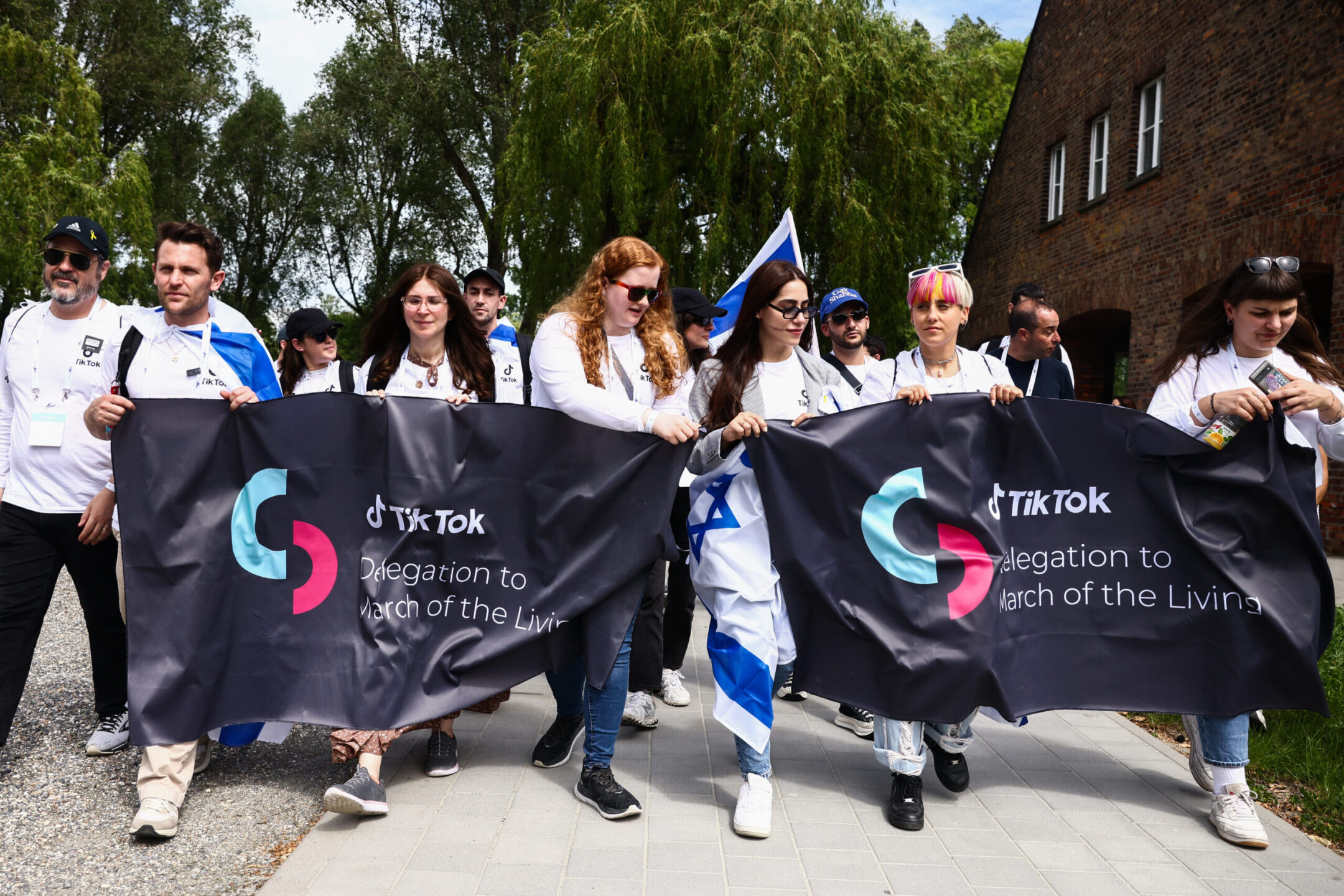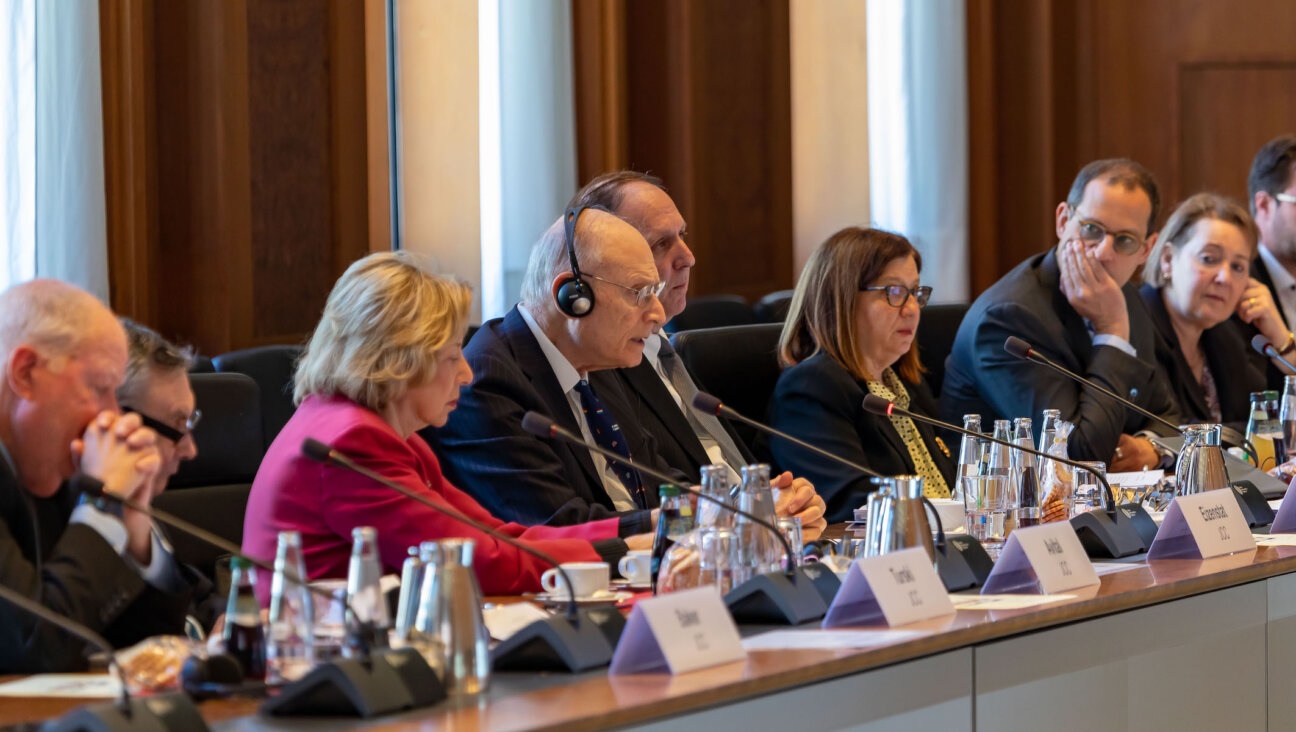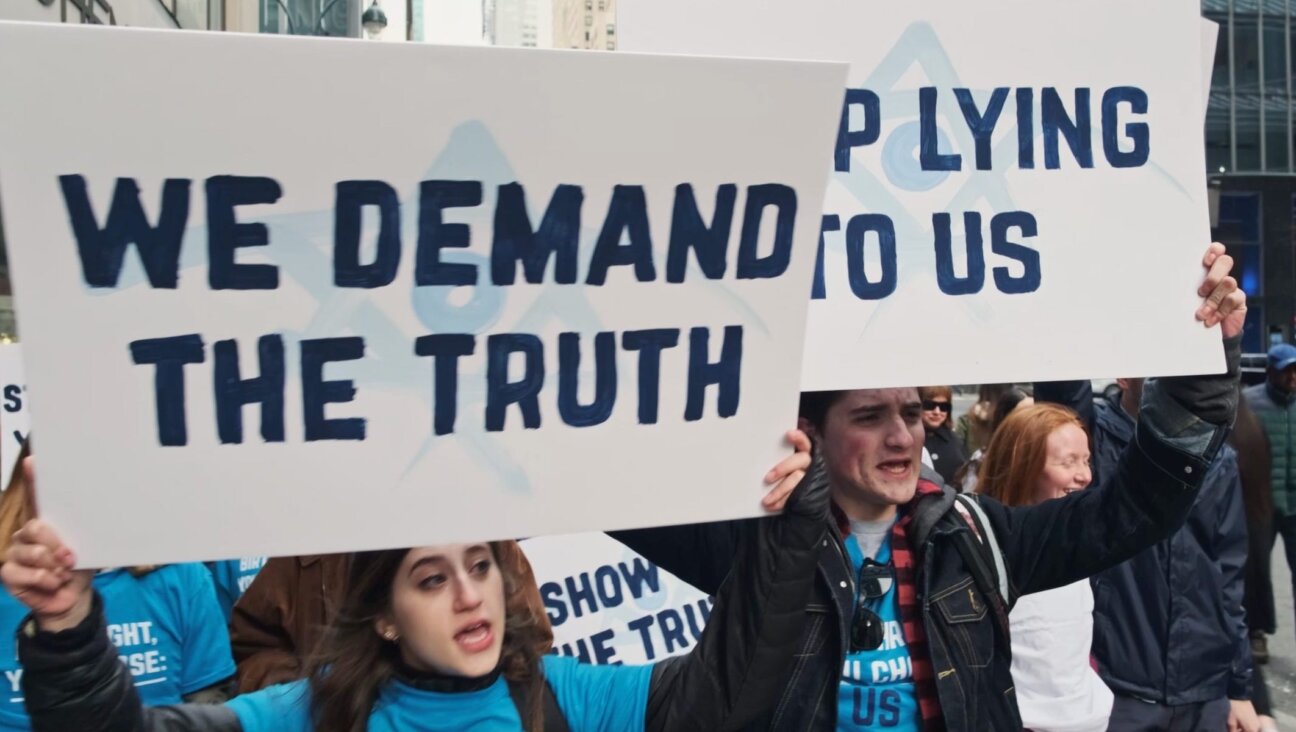At March of the Living on Yom HaShoah, Holocaust survivors and relatives of Oct. 7 victims stress urgency of remembrance
“This is supposed to be never again, but this is again,” said the father of a child who was taken hostage by Hamas and released during a ceasefire

Bellha Haim, whose son Yotam was held hostage in Gaza and killed there by the Israeli army, and Tom Hand, whose 9-year-old daughter was released from Hamas captivity in November, embrace during the International March of the Living at Auschwitz, May 6, 2024. (Deborah Danan)
AUSCHWITZ (JTA) — Bellha Haim, who was born in 1938 and fled the Nazis with her family, swore she would never step foot again in Poland.
Then, on Oct. 7, Hamas invaded Israel, perpetrating the bloodiest day for Jews since the Holocaust — and bringing another tragedy to Haim’s family: Yotam, her grandson, was taken hostage by the terror group. He escaped with friends, only to be killed by Israeli soldiers in a case of mistaken identity in December.
“I can’t believe I’m here. I’m shaking,” Haim told the Jewish Telegraphic Agency outside a barrack in the death camp. She said she believed the Holocaust would never repeat itself.
“But then it did,” she said, referring to the Hamas attack, in which roughly 1,200 people were murdered and 250 taken hostage, including Yotam.
“My walking here today is revenge against all the evil in the world,” she said. “The time has come.”
Haim was visiting Auschwitz as part of the March of the Living, an annual journey that takes thousands of participants, including Holocaust survivors, to Nazi concentration camps in Poland and then to Israel. The group always includes Holocaust survivors; this year, seven months after Oct. 7, they were joined by 23 survivors and relatives of victims of Hamas’ massacre, as well as by TikTok pro-Israel influencers who have battled antisemitism online. People in all of the groups told JTA that this year, the program carries an extra layer of meaning and urgency.
“Every year it’s important to be here,” said Thomas Hand, whose 9-year-old daughter Emily was taken hostage by Hamas and released during a ceasefire in November. “But this year it’s times a hundred more important. We’re living through another Holocaust. We’re actually in one. This is supposed to be never again, but this is again.”
The centerpiece of the itinerary is a march on Yom HaShoah, Israel’s Holocaust Remembrance Day, between the concentration camps Auschwitz and Birkenau, which the group completed on Monday. Budapest-born Laszlo Selly, who lives in Miami and came with a group of high schoolers from Florida, said he felt “tremendous sadness” being in Auschwitz, along with “tremendous hope” for the future.
“Since Oct. 7, it is now more important than ever for these kids to learn about what happens if people with hate in their hearts gain control so that they do everything in their power to prevent it from happening again,” he said.
Born in 1937, Selly was 7 years old when he and his twin brother were rescued from Budapest and hidden during the Nazi occupation of Hungary. Selly’s father escaped from a work camp and returned to Budapest. He and his sons were eventually saved by Swedish diplomat Raoul Wallenberg, who issued diplomatic papers to thousands of Jews, preventing their execution.
“I remember an awful lot,” Selly told JTA. The woman who hid the brothers, he said, was a member of the Nazi-allied Arrow Cross fascist party. Selly said she wore both a swastika and the arrow cross symbol on her uniform. “But maybe she wasn’t a real Nazi,” he added.

Jewish Agency for Israel Chair Doron Almog, Rabbi Yisrael Meir Lau, Chilean businessman Leonardo Farkas, and United Hatzalah CEO Eli Beer speak at Auschwitz during the March of the Living, May 6, 2024. (Deborah Danan)
Some actions on the march drew connections between the Holocaust and Oct. 7 as well. Near Selly, across from the barracks, Jacques Weisser, a hidden child survivor, broke down in tears as he dedicated the final letter in a Torah scroll that was being completed at Auschwitz. Completed by emissaries of the Chabad Hasidic movement, the scroll’s writing had been initiated at the site of the Oct. 7 Nova music festival massacre .
“It’s very special,” said Weisser, who came with the march’s British delegation. “I dedicated the letter to the family that I lost here. It means a lot, obviously. An unbelievable experience.”
The trip also marked a first for Walter Bingham, a 100-year-old Kindertransport survivor who earned the Guinness World Record for being the world’s oldest working journalist three years ago.
“It’s extraordinary being here but very difficult,” said Bingham, who moved to Israel from the United Kingdom two decades ago and lit a torch and said the Mourner’s Kaddish at the event.

Holocaust survivor Walter Bingham participates in the March of the Living at Auschwitz, May 6, 2024. (Deborah Danan)
Bingham also served as a bridge of sorts between young and old. Hundreds of university students were on the trip, and a gaggle of TikTokers surrounded Bingham, hoping to film a clip on the video social platform with the centenarian.
The TikTok users were part of a group of 30 influencers, Jewish and non-Jewish, who came on the March. Five content creators from the United Kingdom, Israel and the United States, who have approximately 30 million followers among them, filmed a video with a call to release the hostages.
American-Israeli influencer Shayna Heidi said Oct. 7 underscored the need to continue remembering the Holocaust.
“Up until now, the Holocaust felt very far. We thought it was in the past and that we’d be won. We had a state,” said Heidi, who has more than 100,000 followers on TikTok. She added, referring to Oct. 7, “But since then we now know we need to carry on spreading the message.”
The march also encountered protest. As the marchers walked over a bridge on the two-mile stretch between Auschwitz and Birkenau, roughly a dozen pro-Palestinian protesters lined the street below, chanting at the marchers.
“To counter a peaceful march just like that, I’m sorry for my expression, but this is so f—ed up,” Youssef Elazhari, the Morocco director of a Middle Eastern dialogue group called Sharaka, told JTA. “I will never tolerate that.”
There were several Muslim and Arab delegations, including from Israel. One was Atidna, which brought a group of Arab Israeli youth. Its leader said he’s seen global perceptions of Israel shift.
“When we first came on March of the Living in 2021, Israel was known as the Startup Nation. In every place in the world, Israelis were in demand,” Suleiman Suleiman, Atidna’s co-CEO, told JTA. “But we chose to tie our fate with the state of Israel and the Jewish people in good and in bad. This is the test.”

Participants of a TikTok delegation attend the 36th anniversary of the International March of the Living at Auschwitz, May 6, 2024. (Beata Zawrzel/NurPhoto via Getty Images)
The trip also included Israeli celebrities. Noa Kirel, who represented Israel at the Eurovision song contest last year and lost relatives in the Holocaust, told JTA it was “meaningful and powerful” to participate.
Adir Miller, a popular comedian and actor, came on the march with his family and mother, a Holocaust survivor who was born in Budapest during World War II. They also visited that city on the trip, which gave Miller an uplifting takeaway amid the discussion of tragedies past and present.
Miller said it was moving “to come here and to Hungary with my mother, who was a baby who they tried to destroy.” He added, “That baby has made it here, three generations later, with her kids and grandkids.”
This article originally appeared on JTA.org.
















